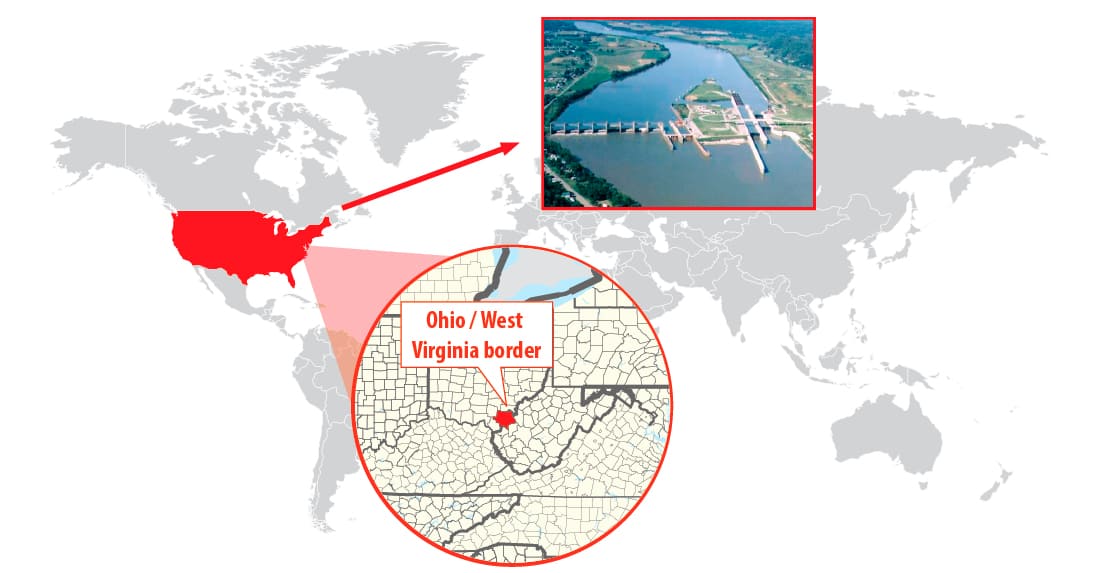
Esclusas y presa Robert C. Byrd en la frontera entre Ohio y Virginia Occidental
Soluciones Aridea, una empresa de ingeniería situada en Virginia Occidental, ha confiado en la Tecnología Libelium para contribuir al desarrollo del programa WIZARD (Dispositivo de investigación del ambiente zoológico intrínseco del agua). La empresa estadounidense trabajó en octubre de 2016 en un proyecto para el Cuerpo de Ingenieros del Ejército de Estados Unidos en la presa y esclusas Robert C. Byrd para controlar las condiciones ambientales de los mejillones. El objetivo era protegerlos cuando trabajen en ríos y arroyos locales. Las esclusas y presa Robert C. Byrd son las décimas de su clase en el río Ohio, situadas en la frontera entre Ohio y Virginia Occidental. Hay 4 esclusas: una para el tráfico comercial de barcazas de 1.200 pies de largo por 110 de ancho, una esclusa auxiliar de 600 pies de largo por 110 de ancho y 2 esclusas paralelas más pequeñas. Como todas las esclusas navegables, la RCB requiere operaciones de dragado para mantener los canales de navegación abiertos y operativos.Control automatizado de las actividades de dragado
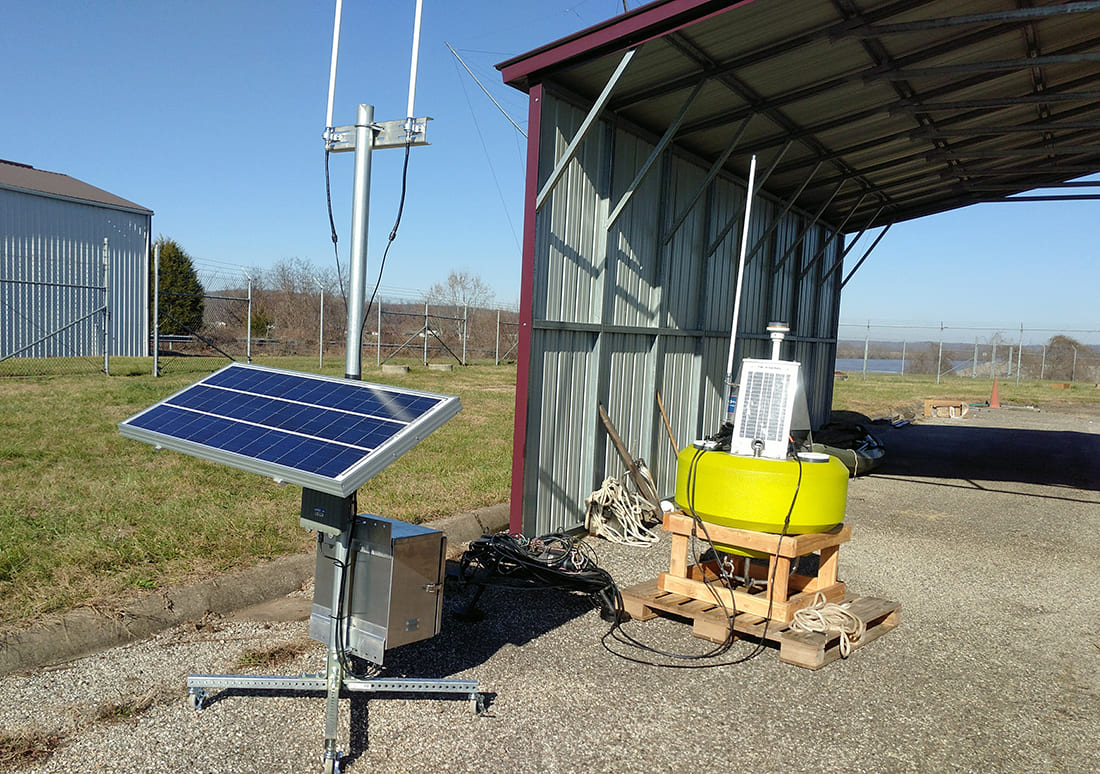
Plataforma de vigilancia WIZARD y Boya Terralytix Edge
Con una media de casi 90.000 yardas cúbicas de material de dragado al año, las necesidades de mantenimiento del canal de las esclusas y presa de RC Byrd superan con creces la media de los proyectos de navegación por el río Ohio. Debido a la importante sedimentación debajo del proyecto, la presencia de mejillones en peligro de extinción y la importancia de la misión de navegación del RC Byrd, las operaciones de dragado y eliminación de residuos en el CR Byrd requieren un examen continuo para cumplir mejor los objetivos. El seguimiento intensivo de los factores medioambientales aguas abajo del vertido de la draga y adyacentes al valioso lecho de mejillones incluye turbidez, sedimentación y oxígeno disuelto. Proporciona transmisiones de datos en tiempo real al Distrito con el fin de controlar las condiciones del agua que podrían afectar a los mejillones.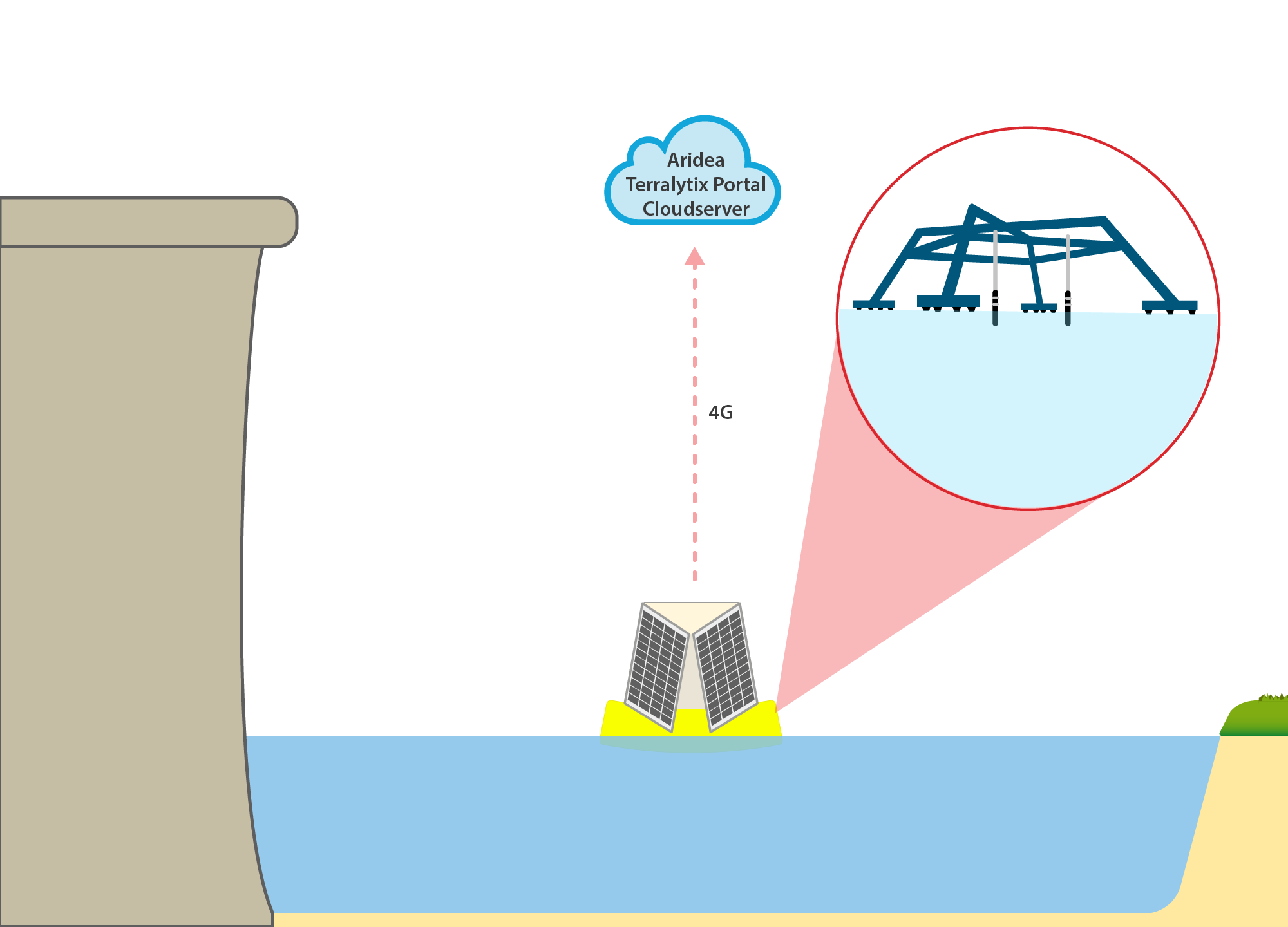
Diagrama del despliegue en las esclusas y presa Robert C. Byrd
La plataforma WIZARD conecta los sensores a la boya Terralytix Edge, que es una boya de comunicaciones alimentada por energía solar compuesta por la Plataforma de sensores Waspmote para registrar y enviar datos; YSI 6920 para medir profundidad y calidad del agua con un transductor de presión y monitorizar la temperatura (F), conductividad (uS/cm), profundidad (m), pH, turbidez (NTU), saturación de oxígeno disuelto (%) y oxígeno disuelto (mg/L); y SeaTek Transducer Array instalado para acumulación de sedimentos y profundidad con un sistema de medición por ultrasonidos. El Conjunto de Transductores Seatek envía los datos recogidos por RS232 y la Sonda YSI a través de SDI12. La información se envía directamente desde la Plataforma de Sensores Waspmote al Portal Terralytix de Aridea a través de 4G. Proporciona una solución increíblemente flexible que permite la recogida y agregación de múltiples parámetros medioambientales a través de una única interfaz que utiliza tecnología de sensores estándar.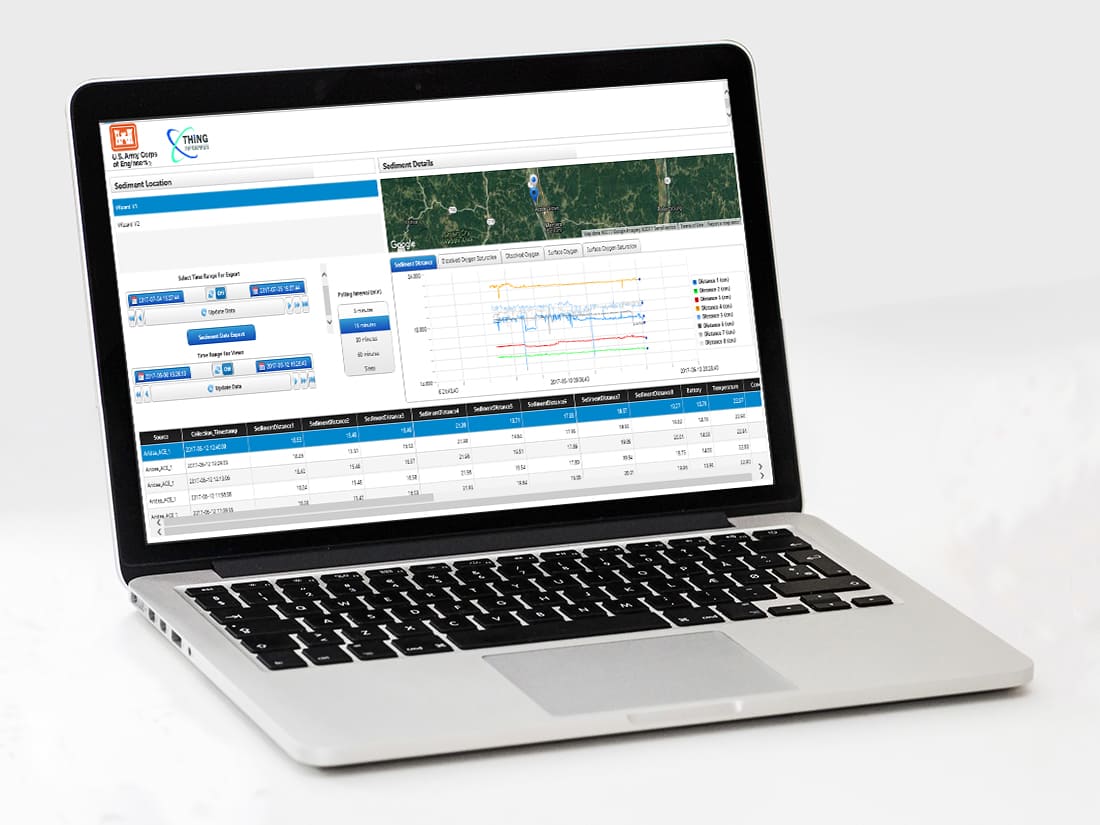
Portal Terralytix de Aridea
«Libelium permite una rápida implantación de soluciones gracias a su compatibilidad con una amplia gama de protocolos industriales. También proporciona una excelente biblioteca de ejemplos de código que permiten máxima flexibilidad en soluciones de ingeniería para nuestros clientes», afirma Rob Moore, director de Ingeniería de Aridea Solutions.Reducir los riesgos para los buceadores y proteger los mejillones
El principal objetivo del proyecto ha sido vigilar y minimizar los efectos de las actividades de dragado sobre las poblaciones locales de mejillones. Por este motivo, Aridea ha entregado una robusta plataforma de deposición de sedimentos y socavación desplegable sobre el terreno, capaz de registrar y enviar datos a intervalos mínimos de 5 minutos.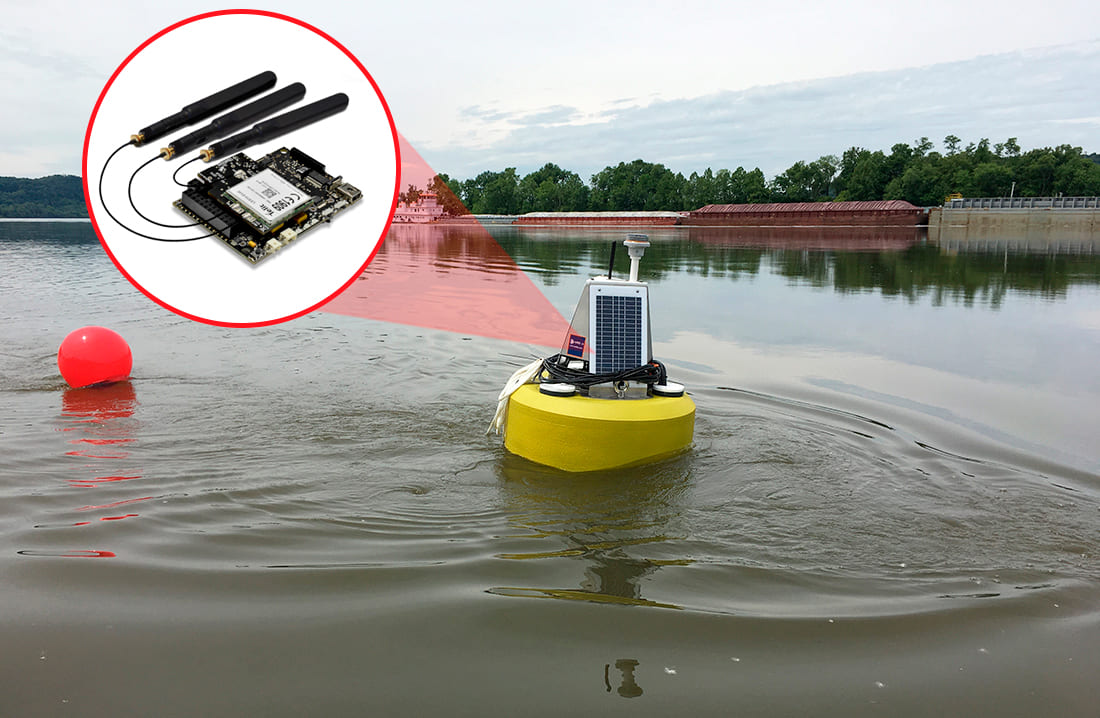
Terralytix Edge Buoy desplegada en el río Ohio, impulsada por Waspmote IoT Core
Para proteger a los mejillones, las compuertas de las esclusas y presa RC Byrd se utilizan ahora de una forma que nunca se pretendió, al dirigir las corrientes creadas por el funcionamiento alternativo de las compuertas para alejar los sedimentos de los criaderos de mejillones. La plataforma WIZARD puede desplegarse sin buzos de 3 a 20 metros de profundidad en el río Ohio desde una embarcación. Esta ha permitido al Cuerpo de Ingenieros del Ejército de Estados Unidos obtener datos del fondo del río Ohio de forma inalámbrica durante el dragado activo sin el gasto y el riesgo para la seguridad de desplegar buzos en el río.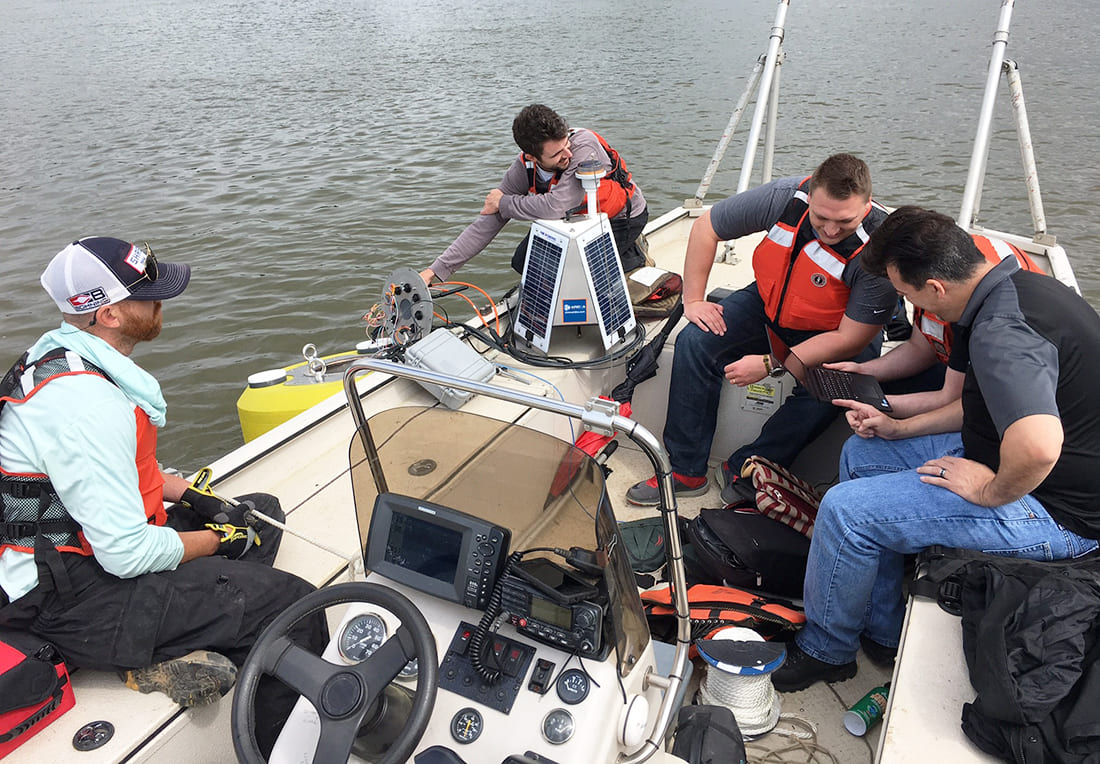
El equipo de Aridea y miembros del Cuerpo de Ingenieros del Ejército de EE.UU. durante el despliegue de WIZARD.
«Estas innovaciones han sido bien recibidas por nuestros socios de otros organismos de recursos estatales y federales y han permitido al Distrito seguir operaciones rentables de eliminación en el agua», ha señalado Steve Foster, limnólogo del Cuerpo de Ingenieros del Ejército de Estados Unidos. Si desea más información sobre nuestros productos, póngase en contacto con el Departamento de ventas de Libelium. Si desea descargar el artículo en español, por favor pulse aquí.Más información:
Referencias:
Descárguelo en English🇬🇧 y Spanish🇪🇸 directamente en su bandeja de entrada.
Descargar*TÉRMINOS Y CONDICIONES PARA UTILIZAR EL CONTENIDO DE LIBELIUM. Libelium es el propietario de todas las imágenes proporcionadas en el sitio web y sólo pueden utilizarse citando la fuente. Cualquier vídeo, fotografía, diagrama, infografía o logotipo no puede ser utilizado o transformado sin la autorización de Libelium. Puede solicitar los archivos en alta resolución para publicarlos en su web o insertarlos en folletos de marketing siempre utilizando el logo de Libelium y enlazando con la web de Libelium. Si va a publicar el artículo en una web o medio de comunicación o en un libro blanco o estudio de investigación, deberá hacerlo incluyendo todas las referencias y mencionando a Libelium como fuente del contenido. © Libelium Comunicaciones Distribuidas S.L. - www.libelium.com
Mantente al día en IoT
Únete a la Comunidad Libelium y recibe las últimas noticias sobre IoT, eventos importantes, proyectos, casos de éxito y mucho más en su inbox.
Más de 18 años de experiencia en IoT.


















© Libelium Comunicaciones Distribuidas S. L. | Términos y condiciones | Política de privacidad | Política de Cookies | Política de Seguridad | Canal del informante